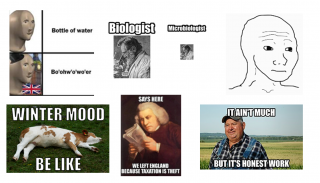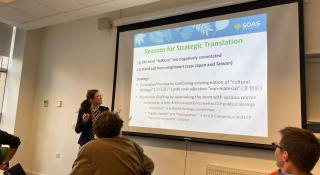
Breadcrumbs navigation
Theorising the memescape: The spatial politics of Internet memes
Uygar Baspehlivan discusses the key arguments from his new Review of International Studies (RIS) article. If you'd like to know more you can read the full article here - Theorising the memescape: The spatial politics of Internet memes.
How do we understand and act in a world where internet memes – endlessly replicable and seriously non-serious digital bits of culture – are becoming increasingly predominant modes of online and offline communication and political formation? My article starts from this question and interrogates and theorises the new global politics of internet memes. Using the works of French philosopher duo and radical theorists Gilles Deleuze and Felix Guattari, I argue that the best way to understand and act on this new world of global political possibility is to start from a spatial reading of what I call the “the memescape”. The memescape, shortly, is where memes circulate. It involves not only memes but also political subjects whose lives become enmeshed in and affected by the circulation of memes as well as discourses, affects, technological infrastructures, and political, economic, and cultural systems of organisation that make possible the circulation of these memes. The article’s central claim is that if we are to make political sense of not only the present but also the future possibilities of this novel space of action, we need to first unpack the spatial logic of the memescape, how memes circulate, and what these circulations entail.
How is “the memescape” a space? Here, I move against traditional conceptions of ‘space’ in international relations that conceptualise spaces as territorial containers over which nations exist and take a critical and relational approach inspired by the work of Deleuze and Guattari, as well as critical geographers such as Doreen Massey, in which spaces are understood as a product of interrelations. Spaces emerge through processes of interrelation where various subjects, objects, discourses, and effects come together in creating different political, social, and cultural potentials for action. These potentials shift and change as the elements within a particular spatial configuration move, transform, connect, and clash within themselves as well as with other spatial configurations which may produce differential paths for political and social action. This means that not all spaces are the same and, as Deleuze and Guattari crucially argue, their spatial relations are distributed across differential lines of potential. Spatial relations differ from one another according to the potential connections, movements, and interactions that are allowed or disallowed across their politically, socially, materially, and culturally organised contours. What can be done, said, and felt in the memescape will be different in potential than what can be done, said, and felt in an academic conference or in a diplomatic meeting.
According to Deleuze and Guattari, what spaces can do and allow in potential may be divided into two opposite but mutually interacting concepts of smooth and striated spaces. A striated space is organised centrally and hierarchically which delimits the movements, potentials, and identities of the elements. A smooth space, on the other hand, tends towards decentralised, a-hierarchical, and multiple relations producing possibilities for unexpected movements, associations, and transformative connections between the elements within. These concepts do not refer to necessarily stable relations of difference. No space is perfectly smooth or striated but rather they tend towards one or the other but always in mixture, movement, and tension with each other. Also, these spaces are not normatively configured. A smooth space is not necessarily good or emancipatory and a striated configuration is not always necessarily oppressive. In the article, I argue that we can understand the bordered governance spaces of the international as striated and the more dynamic, open, and decentralised site of the memescape as engendering relatively more smooth relations. The novel site of relation between the relatively striated space of the international and the relatively smooth space of the memescape, I argue, creates new potentials for how global politics can be navigated.
I argue that the spatial logic of the memescape tends towards smooth relations through three properties:
- The memescape is rhizomatic. Memes predominantly do not propagate top-down from a hierarchical logic of active content producers to passive masses as reactive bodies. Memes are reciprocally co-produced between a variety of political subjects, are cheap and easy to make, and are not subject to formal aesthetic standards and review. Aesthetic production, then, is reciprocal, collective, and decentralised. I argue that rhizomatic space of relation thus creates a site of potentiality from which various political subjects can circulate discourses and affects outside traditional media structures. Memes also refuse to be fixed. They are in continuous variation as different people can take up different memes, mix them, sample them, subvert, and change them to constantly re-arrange the content, meaning, and form of a particular circulation. As such, memes do not have a predetermined path of dissemination and circulation and a meme’s circulation can take continually differentiating routes of articulation. This spatial relation thus allows for memes to escape dominant structures and spaces of knowledge in the international.
- The memescape is nomadic. The predominant mode of expression and interaction in the memescape is of non-seriousness, play, and humour where the stable constants of knowledge regimes, truth, and meaning as produced by striated spaces become open to silly and non-sensical interruptions, movements, and subversions. Meaning and signs that stabilise common understandings in international politics, here, start to move in unexpected ways, allowing what is otherwise familiar to become unfamiliar through parodic, ironic, and humorous interruptions.
- The memescape is multiple. Memes move people. They are enjoyable, affective phenomena which make possible the coming-together of a multiplicity of political subjects by the virtue of their affective resonance. A meme’s simple, immediate, and resonant affective impact, as well as its instant translatability and templatability, potentialise lines of relation between and across different languages, ideological lines, cultures, and borders where affective sentiments can be circulated, embodied, and felt in commonality.
Through these three spatial properties, I argue, the memescape’s spatial logic tends towards a relatively smooth logic whereby novel transformative potential for the processes of global politics can become possible. However, I argue, these spatial properties of decentralised co-production, humorous interruption, and affective multiplicity do not always and necessarily make possible positive and/or emancipatory political paths. A rhizomatic relation outside dominant knowledge structures does not necessarily entail an absence of various power relations but offer a new path where those power relations can be re-iterated in alternative spaces of circulation. Nomadic, humorous interruptions do not always shift meaning towards the deconstruction of power, but rather may ambiguate and mystify the presence of relations of violence and power under detached, ironic, and seemingly transgressive modes of expression. Affective multiplicity does not necessarily entail the coming-together of resistance masses but may rather bring together reactionary desires and bodies through affectively resonant relations of hate, anger, and ressentiment.
Therefore, the memescape is a complex site of politics productive of divergent paths. To show these divergent paths within its smooth contours, I put forward two examples. First, the article looks at how Indigenous communities in Australia engage with the smooth space of the memescape to deconstruct, demystify, and mock the hegemonic logic of colonial border regimes. The memescape allows a rhizomatic site outside traditional spaces of knowledge production by a particular settler colonial state apparatus where anti-colonial and decolonial knowledges and experiences may circulate. It allows a nomadic site where widespread and entrenched settler colonial myths and understanding can be subverted through playful, humorous, and widely accessible interruptions. Finally, it instantiates various affective connections between cross-border Indigenous experiences and subjectivities where common global struggles can be articulated and felt. Second, however, I also show these varied relations have become productive of reactionary mobilities and sensibilities that accelerate in and through the memescape. Looking primarily at the meme-filled white supremacist manifestos of various shooters across the world over the last couple of years, I show how the relatively smooth logic of the memescape contributes to and engenders a transnational reactionary politics. Here, we find how the rhizomatic logic allows reactionary thought that might otherwise be frowned upon in public spaces to percolate under unseeming spaces of everyday articulation. We find how the nomadic humour of this space, in continually moving between the ironic and the non-ironic, the funny and the serious, ambiguates expression and allows reactionary networks to leak through subcultures and in-jokes. We also find how memes allow reaction to become enjoyable and pleasurable, making possible resonant articulations of resentment and anger in comic form.
In conclusion, looking at the divergent paths that become possible from the relatively smooth logic of the memescape, the article argues for a more sustained and careful ethical and scholarly attention to be paid to it. A spatial approach to the memescape, here, allows us to see memes as more than just singular artefacts but as a broader space of interrelation that constitutes and imparts new potentials for how global politics can be navigated and transformed by a multiplicity of actors.
Want to know more? You can read the full article at DOI: https://doi.org/10.1017/S0260210523000049
This particular article is open access, however BISA members receive access to RIS (and to our other journal European Journal of International Security) as a benefit of membership. To gain access, log in to your BISA account and scroll down to the 'Membership benefits' section. If you're not yet a member join today.
Top images sourced from Wikimedia Commons: Itzmxhsin (top left), Russian public domain (top middle), No se sabe (top right), PantheraLeo1359531 (bottom left), Ronenspierer (bottom middle), Cakelot1 (bottom right).


